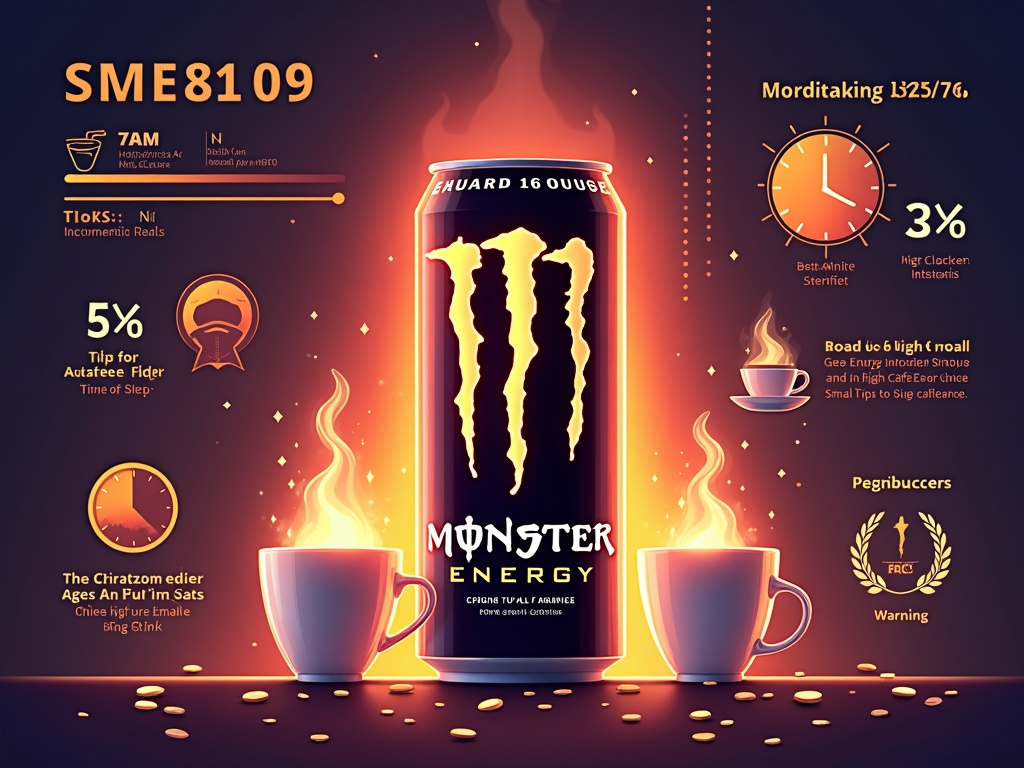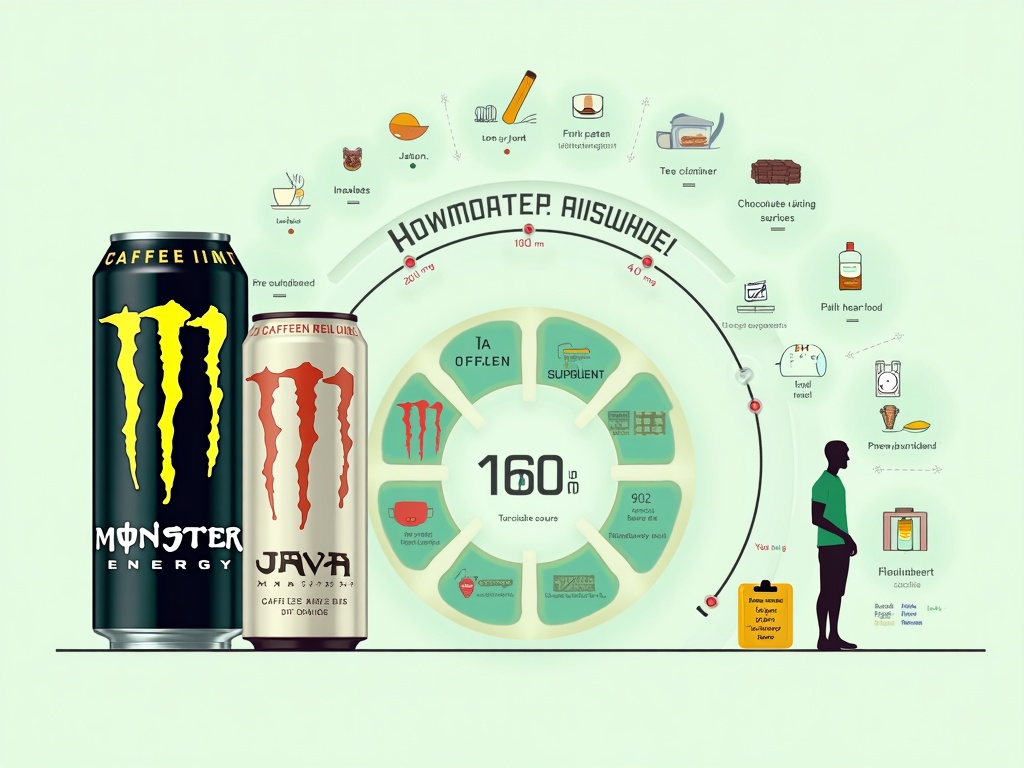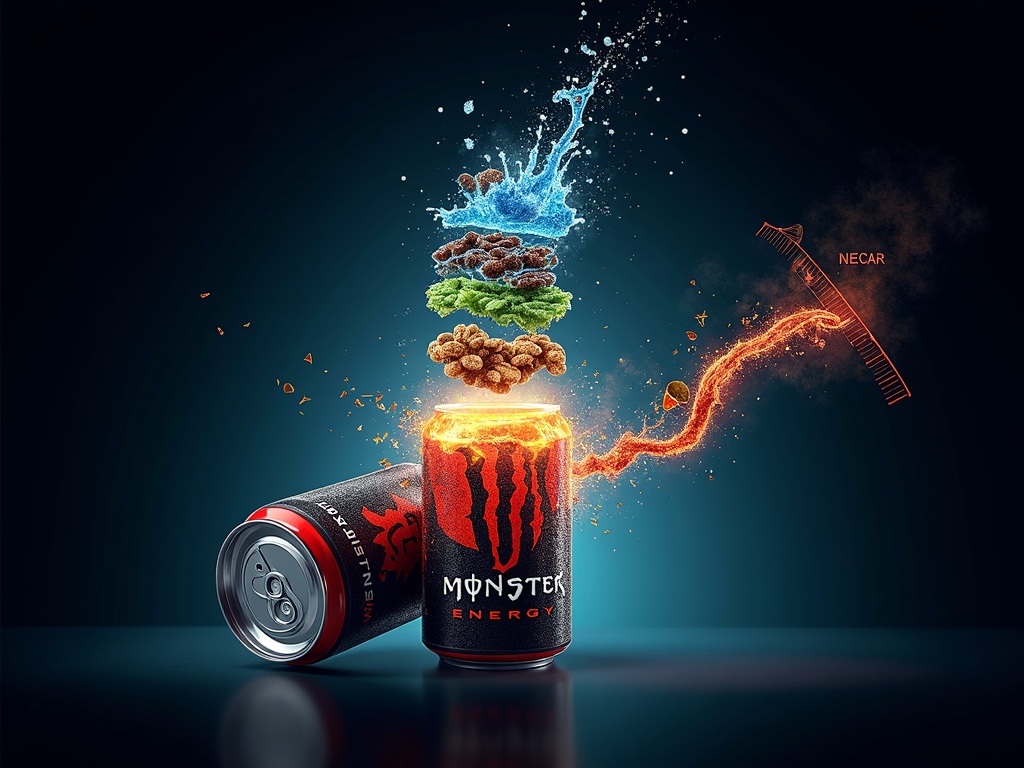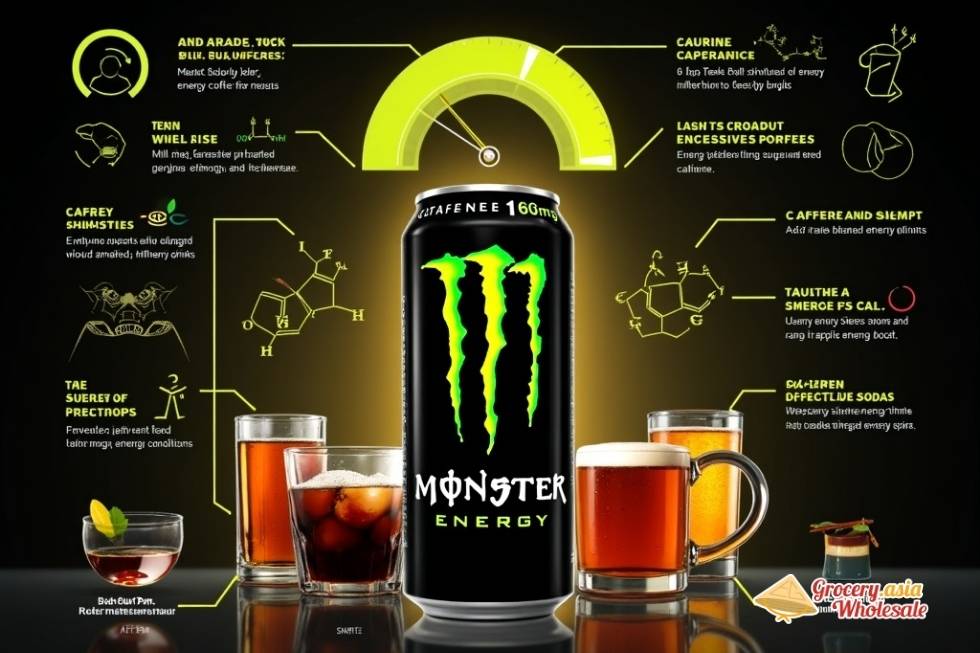No products in the cart.
Beverages News, Energy Drinks, Monster Energy Drink
How Much Caffeine Is In A Monster Energy Serving
A standard 16 fl oz Monster Energy drink contains exactly 160 milligrams of caffeine, which equals approximately 10 mg per fluid ounce and represents about 40% of the FDA’s recommended daily caffeine limit for healthy adults. This caffeine content places Monster in the middle range of energy drinks, delivering roughly the same stimulant effect as two small cups of freshly brewed coffee.
Table of Contents
Key Takeaways
- Monster Energy contains 160mg of caffeine per 16 fl oz can, with Java Monster varieties containing the highest amount at 200mg per 15 fl oz can.
- One Monster fits within FDA caffeine limits for adults (400mg), but exceeds recommended limits for teenagers (100mg daily).
- Monster delivers significantly more caffeine than sodas like Coca-Cola (34mg per 12 oz) but less than large specialty coffee drinks.
- The energy blend includes additional stimulants like guarana extract, which may add 10-30mg of unlisted natural caffeine per can.
- Monster contains 54 grams of sugar per can, which exceeds daily recommended sugar intake limits and contributes to the immediate energy boost alongside caffeine.
A Standard Monster Contains 160mg of Caffeine – Is That a Lot?
A standard 16 fl oz can of the original Monster Energy packs exactly 160 milligrams of caffeine. The nutrition label breaks this down into two 8 fl oz servings at 80 mg each, but let’s be honest – most people down the entire can in one session. This works out to approximately 10 mg of caffeine per fluid ounce, making it a concentrated source of this stimulant.
Comparing Monster’s Caffeine Content
That 160mg delivers roughly the same caffeine punch as two small cups of freshly brewed coffee. To put this in perspective, a typical 8 oz cup of coffee contains between 70–140 mg of caffeine, depending on the brewing method and bean type. Monster’s caffeine content sits comfortably in the middle range compared to other energy drinks on the market.
Your individual response to this amount varies significantly based on your caffeine tolerance. Regular coffee drinkers might barely feel the effects, while those who rarely consume caffeine could experience jitters, increased heart rate, or difficulty sleeping. Body weight, age, and certain medications also influence how your system processes caffeine.
Is 160mg Considered Excessive?
For most healthy adults, 160mg falls within moderate consumption levels. The FDA considers up to 400mg of caffeine daily as generally safe for adults – that’s about 2.5 cans of Monster. However, it’s wise to start with smaller amounts if you’re new to energy drinks or have caffeine sensitivity.
Pregnant women, teenagers, and individuals with heart conditions should exercise extra caution. The American Academy of Pediatrics suggests teens limit caffeine to 100mg daily, making one Monster can exceed this recommendation.
Timing matters just as much as quantity. Consuming 160mg late in the day can disrupt sleep patterns since caffeine’s effects last 6–8 hours in your system. It’s best to enjoy Monster energy drinks before 2 PM to avoid interfering with nighttime rest.
The concentration in Monster makes it easy to consume significant caffeine quickly. Unlike sipping coffee over an hour, you might drink an entire can in minutes, delivering that full 160mg dose rapidly. This faster absorption can intensify both positive effects and potential side effects.

Monster Varieties: How Caffeine Content Changes Across Products
I’ve analyzed the caffeine content across Monster’s extensive product lineup, and the variation might surprise you. Each variety offers a different caffeine experience, allowing you to select based on your specific needs and tolerance levels.
Standard Monster Products
Original Monster Energy delivers the classic experience with 160 mg of caffeine per 16 fl oz can. Lo-Carb and Zero Sugar varieties maintain this same caffeine content, along with most traditional flavors in the lineup. Monster Ultra Series products, including Zero Ultra, Red, and Blue, contain slightly less at 150 mg per 16 fl oz can—a minor reduction that many consumers won’t notice.
Monster Rehab products, featuring the popular Tea + Lemonade combination, pack 160 mg into a 15.5 fl oz can. Dragon Tea follows closely with 155 mg in the same 15.5 fl oz size, while Monster Muscle contains 157 mg per 15 fl oz can.
Specialty Varieties and Their Unique Profiles
Java Monster stands out as the highest-caffeine option in the Monster family. Mean Bean, Loca Moca, and other coffee-based varieties contain 200 mg per 15 fl oz can. This elevated caffeine level stems from the coffee base, making Java Monster ideal for serious caffeine enthusiasts or those replacing their morning coffee routine.
Monster Hydro Energy Water takes a different approach with 125 mg per 20 fl oz bottle. While this represents the lowest concentration in the Monster lineup, the larger serving size still provides substantial caffeine content. This option works well for those wanting sustained energy without the intensity of traditional energy drinks.
The range spans from 125 mg to 200 mg across different Monster products, giving you flexibility based on your caffeine preferences and tolerance. Coffee lovers gravitate toward Java Monster for maximum impact, while those preferring moderate stimulation often choose Ultra varieties or Hydro options. Understanding these differences helps you make informed decisions about Monster Energy caffeine consumption based on your individual needs and daily routine.
How Monster Compares to Other Caffeinated Drinks
I often find that people underestimate just how much caffeine Monster Energy drinks contain compared to their daily beverages. With 160 mg of caffeine in a standard 16 oz can, Monster packs significantly more punch than most sodas while still falling short of premium coffee drinks.
Monster vs. Coffee
Coffee lovers might be surprised to learn that Monster doesn’t always win the caffeine battle. An 8 oz cup of brewed coffee delivers about 95 mg of caffeine, which means you’d need roughly two cups to match Monster’s caffeine content. However, larger coffee servings quickly surpass Monster’s levels. A 16 oz Starbucks Pike Place Roast contains approximately 310 mg of caffeine—nearly double what you’ll find in Monster. Even a single 1 oz espresso shot provides 64 mg, so a triple shot latte would exceed Monster’s caffeine concentration.
Comparing Monster to Sodas and Other Energy Drinks
Monster absolutely dominates traditional sodas in the caffeine department. Consider these stark differences:
- 12 oz Coca-Cola contains just 34 mg of caffeine, making Monster roughly 4-5 times stronger
- Diet Coke steps up slightly with 46 mg per 12 oz, but still falls far short of Monster’s potency
- An 8 oz cup of black tea provides around 47 mg, less than one-third of Monster’s concentration
- Red Bull, another popular energy drink, contains 80 mg per 8 oz can—exactly half of what you’d get from the same volume of Monster
These comparisons reveal that Monster occupies a unique position in the caffeine spectrum. It delivers more stimulation than sodas, teas, and even some coffee drinks, yet doesn’t reach the extreme levels found in large specialty coffee beverages. This positioning makes Monster appealing to people who want more energy than soda provides but don’t want to commit to the higher caffeine doses found in large coffee drinks.
The 160 mg caffeine content places Monster firmly between standard coffee and high-caffeine specialty drinks. This middle ground explains why many people choose Monster as their go-to energy source—it provides substantial stimulation without reaching the potentially overwhelming levels found in some coffee shop creations. Understanding these comparisons helps you make informed decisions about your caffeine intake throughout the day.
Is One Monster Within Daily Safe Caffeine Limits?
I can confidently say that one Monster energy drink fits within the FDA’s recommended daily caffeine limits for healthy adults. The FDA sets the safe upper limit at 400 mg of caffeine per day, and a standard Monster contains 160 mg of caffeine, which represents 40% of this daily allowance.
Understanding Your Daily Caffeine Budget
If you choose a Java Monster instead, you’ll consume 200 mg of caffeine, accounting for 50% of your daily limit. This leaves you with room for other caffeinated beverages or foods throughout the day, but you need to track everything carefully.
I recommend monitoring all your caffeine sources throughout the day, including:
- Coffee and espresso drinks
- Tea varieties (black, green, white)
- Sodas and other energy drinks
- Chocolate products
- Over-the-counter medications
- Pre-workout supplements
Recognizing When You’ve Had Too Much
Exceeding the 400 mg daily limit can trigger uncomfortable and potentially dangerous side effects. I’ve seen people experience insomnia, jitters, anxiety, rapid heart rate, nausea, or headaches when they consume too much caffeine. These symptoms indicate your body is struggling to process the excess stimulant.
Moderate consumption becomes even more critical for specific groups. Teenagers should limit their intake significantly since their bodies process caffeine differently than adults. People who are sensitive to caffeine may experience adverse effects even below the recommended limits.
If you’re drinking Monster regularly, I suggest keeping a caffeine diary to track your total daily intake. Remember that caffeine in Monster energy drinks varies between flavors and sizes, so check labels carefully.
The key lies in understanding that one Monster won’t push you over the edge, but it does use up a significant portion of your daily caffeine budget. Space out your consumption throughout the day rather than consuming multiple energy drinks in a short period. This approach helps your body process the caffeine more effectively while reducing the risk of side effects.
For those wondering about specific caffeine amounts in different Monster varieties, always check the product label since formulations can change. Your individual tolerance plays a major role in determining whether one Monster feels comfortable or overwhelming for your system.

Beyond Caffeine: Monster’s Extra Energy Ingredients
I’ve discovered that Monster Energy’s power extends far beyond its primary caffeine content. The company’s proprietary “Energy Blend” combines multiple ingredients that work together to create that distinctive energy boost you feel within minutes of consumption.
The Energy Blend Breakdown
Monster packs five key components into its energy blend, each serving a specific purpose:
- Taurine acts as an amino acid that may help with cardiovascular function and muscle performance
- L-Carnitine assists your body in converting fat into energy at the cellular level
- Guarana Extract provides additional natural caffeine beyond what’s listed on the label
- Panax Ginseng offers adaptogenic properties that may help with focus and endurance
- B Vitamins support your metabolic processes throughout the day
Guarana deserves special attention because it contains natural caffeine that isn’t included in Monster’s stated caffeine count. This South American plant extract can add anywhere from 10 to 30 additional milligrams of caffeine per can, meaning your actual caffeine intake from Monster might be higher than the 160mg listed on the label.
B Vitamins play a supporting role rather than providing direct energy. Niacin, B6, B12, and Riboflavin help your body process nutrients more efficiently, but they won’t give you that immediate rush you’re looking for. These vitamins work behind the scenes to support your metabolism, making them valuable for sustained energy production over time.
Sugar represents Monster’s most immediate energy source, and it’s worth understanding the numbers. A 16-ounce original Monster contains 54 grams of sugar — that’s more than the American Heart Association recommends for an entire day. Men should limit sugar intake to 36 grams daily, while women should stay under 25 grams. This means one Monster can contains roughly 1.5 to 2 times your recommended daily sugar allowance.
The immediate energy “kick” you experience after drinking Monster comes primarily from this caffeine-sugar combination. Sugar provides instant glucose to your bloodstream, while caffeine blocks adenosine receptors in your brain that normally signal tiredness. This dual action creates that familiar surge of alertness and energy that peaks within 30 to 60 minutes of consumption.
I recommend paying attention to timing when consuming Monster drinks. The sugar component will cause a rapid spike in blood glucose, followed by a potential crash 2 to 3 hours later as your insulin response kicks in. Caffeine’s effects last longer, typically 4 to 6 hours, which means you might feel alert even as your blood sugar drops.
Understanding these ingredients helps you make informed decisions about when and how to use Monster Energy drinks effectively. The combination works well for short-term energy needs, but relying on this sugar-caffeine combo regularly can lead to tolerance and energy fluctuations throughout your day. Consider your individual caffeine sensitivity, current sugar intake, and energy needs before making Monster a regular part of your routine.

Sources:
Monster Energy Official Website
U.S. FDA, “Spilling the Beans: How Much Caffeine Is Too Much?”
Mayo Clinic, “Caffeine: How Much Is Too Much?”
Caffeine Informer, “Caffeine in Monster Energy Drink”


